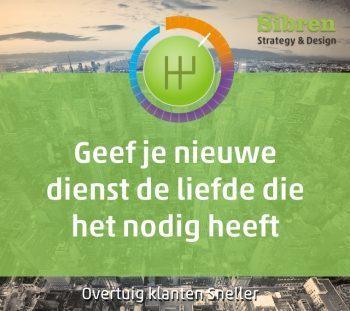
Customers force you to constantly adjust, improve or undertake new experiments. In addition to the existing ones, you also have to invent, test and market new services or products while you continue to provide the current services.
For smaller companies, this extra capacity is not available outside of regular working hours. Just hiring extra people to put the new service "on the market" for them is not really an option for them. The time is up at the start of the week, who-so-so!
Give your new service the love it needs - Sibren van der Burgt
Lack of love
I often see - also at my own company - that there are many plans and ideas for new or additional services, or for a shift in earning models and type of customers.
Making a start often works. For this, the director or founder of the company still makes some (free) time to sacrifice, purely because he is enthusiastic. But then it stays. Somewhere. Where it is not in the way. To languish due to lack of attention and love ...
With a Software customer, we are constantly working to ensure that new services match customer problems. That regularly means that we have to change the offer or proposition, while the core service does not really change. There is a lot of "liquid code" in software. This is very useful, because you are very flexible in offering new applications (extra options for the user) and offering the same solution to other target groups.
Reaching a new customer group is different
While the software can "reasonably easily" serve new services and customers, it is often more difficult to get it actually sold.
Selling more / new services to existing customers is relatively easy. Software companies often develop new services together with a (couple of) customers by looking at and listening to market developments, needs and opportunities.
But what if your new solution no longer belongs to the existing customer group? The software can often solve multiple problems, but a solution without a customer problem has no chance. If that customer problem is outside of your current clientele, then you need to actively approach, question, test, show a good "mockup" and more actions.
Approach to a proposition idea
That's how it happened for my own company. I have been playing with the idea for a new service for some time: the remote marketing department. You rent it for a fixed amount per month, so very predictable costs and you can cancel it again per month. Ideal for companies that need extra capacity to set up marketing and promotion for a new service.
Customers can simply start the subscription and decide per month if it makes sense to continue. For customers, there are many uncertainties in setting up a new service, so you want to be able to change quickly, and you don't want to be tied to anything. With a subscription the customer runs a low risk and the costs are manageable "experiment". Once you are up and running again, the extra capacity of the remote marketing department can be disconnected.
Agile experimentation works best
When experimenting with a new service, it is important to tackle the agile - say as a lean start-up. In addition, it is especially important to properly execute the process (the iterations) and to start with the problem-solution fit:
- Who pays you for the solution of which problem without hassle enough money for your service? -
If you have discovered through experiments what the problem-solution fit is and you have looked at how it fits into your business model, it is time to market it. Making your service / product visible / tangible and investigating how marketing prospects really want to pay for it. You also do this process in an agile / lean way with iterations and "learning cycles".
Test quickly
With our new product "the remote marketing department" I did not have to think long about the revenue model. That is a standard subscription model that my SaaS customers also have. The services are also not new (just like with the software) because they are all productised (individual products, put together in programs).
But the proposition is completely new, and the barriers to buying the product are different; I have set up the proposition with assumptions. Our back-end developer is now adding 2 test websites to the existing company website sibren.nl in which the proposition can be seen later. Those 2 sites are quickly set up with 80% existing content; with the Craft 3 CMS - which we use for almost all web development projects - it is possible to use and control the same content on multiple websites. Ideal for experiments and for multiple product websites with the same look & feel.
The customer feedback questionnaire about the new service has already been created..



